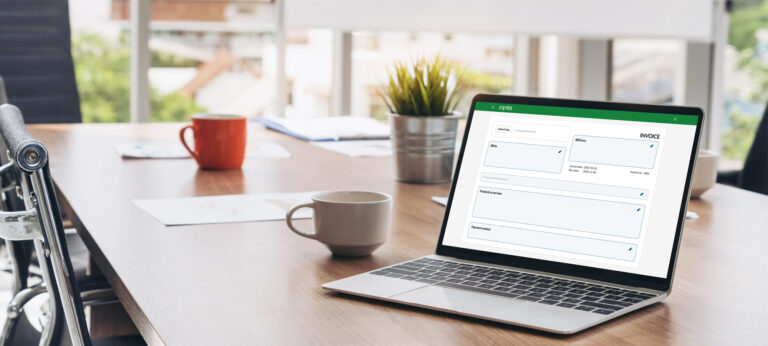A lot of invoices are paid late. In this guide, we’ll explain different payment terms and look at how you can get paid on time.
Did you know that 55 percent of invoices in the US are paid late? But don’t despair, there are some things you can do to increase your chances of getting paid on time—or even early!
First, let’s take a look at what payment terms are.
Pro-tip: Invoice software can help you get paid faster
With invoicing software it’s quick and easy to make invoices. That means you can send the invoices to your clients faster—either from your laptop or phone. You also get notified about overdue payments so that you can follow up with clients.
What are payment terms?
Payment terms outline how clients should pay: Either via bank account transfer, in cash or via a payment gateway such as PayPal or Stripe. Payment terms also outline when the clients are expected to pay for the goods or services you’ve provided. They can also include late fees or early payment discounts.
By providing clear payment terms, you can streamline the payment process and make it easier for your customers to pay you. Payment terms are vital for managing your business’ finances, making informed business decisions, and maintaining a healthy cash flow.
💰 Example of payment terms
Thank you for doing business with us! We appreciate your prompt payment. Payment is due within [x] days from the date the invoice was issued invoice. You can pay via these methods:
[Information about payment methods]
Late payments will be subject to a [percentage fee or flat fee]. Please reference the invoice number [number] when making the payment. Any discrepancies should be reported within [number of days] days of receipt. We look forward to continuing our business relationship with you!
What types of payment terms are there?
It’s usually the business owner or the head of accounting who determines payment terms.
Typical payment terms vary from industry to industry, which country a business operates in, and how willing you are to extend credit to customers. Choosing the right payment terms requires you to consider your business goals, payment amounts, and term options. Some strategies include:
- Prepayment, where clients pay upfront. This reduces the risk of non-payment.
- Upfront percentage, where clients pay a part upfront and the remainder later.
- An instalment agreement, where clients pay in instalments over a specified period.
- Payment after invoice date, such as 14 or 30 days after the invoice has been issued.
When companies negotiate payment after invoice date, they often operate with net days. Net days indicates the timeframe within which you expect to get paid:
- PIA: Payment made in advance.
- Net 7: Payment due seven days after the invoice date.
- Net 10: Payment due ten days after the invoice date.
- Net 30: Payment due thirty days after the invoice date.
- Net 60: Payment due sixty days after the invoice date.
- Net 90: Payment due ninety days after the invoice date.
- EOM: End of the month.
- 21 MFI: 21st of the month following the invoice date.
Standard payment terms are between 12-30 days from when the invoice is issued.
See also: How to send an invoice (2024).
How do I decide on payment terms?
1. Consider the client history
You should tailor your payment terms on client behaviour. If you continually chase down a client for payment, you might want to ask that client for payment upfront.
- For notoriously late clients, you can consider stricter policies like upfront payments or cash on delivery.
- For prompt clients, you can consider early payment discounts to strengthen your relationship.
Pro-tip: Run a credit check on new clients
A credit check can help you know which clients should pay upfront or on delivery, and which clients can pay by instalments or after the goods or services have been delivered.
2. Consider your cash flow
Evaluate whether you consistently face cash shortages towards the end of the month or struggle to kickstart operations due to insufficient funds at the beginning of the month.
The best invoice terms for your cash flow are those that quickly gives you money, such as:
- Upfront payments
- 50 percent upfront payments
3. Experiment with creative terms
Get creative with your payment terms to encourage timely or early payments. You could for instance offer a 5 percent discount for clients who pay within seven days.
4. Take industry standards into account
Industries may have different norms based on risk, upfront costs, and project timelines. Look into which payment terms are common in your industry and make sure you align with that to some degree.
5. Add late fees and interest terms
Incentivise timely payments by stating that late fees and interests will apply if the customer fails to pay on time.
How should clients pay?
Selecting the right payment methods for your business is crucial both to make it easy for clients to pay and to ensure that you get paid on time. Consider which of the following payment methods you want to offer your clients?
- Cash
- Bank transfers
- Debit cards
- Credit cards
- Online payment systems
- Mobile payment solutions
By offering a combination of these methods, your business can provide flexibility and convenience and encourage them to pay on time, or even early.
If clients pay late, we recommend that you remind them as soon as possible, but use polite language: Research shows that invoices including the words “please” and “thank you” get paid five percent faster than other invoices.






